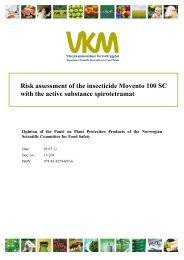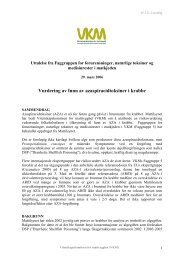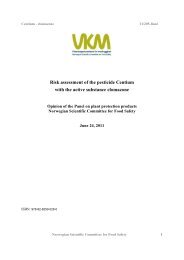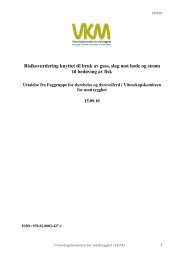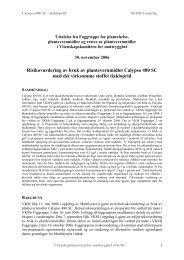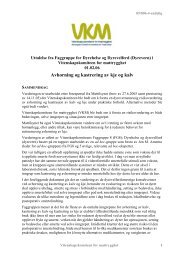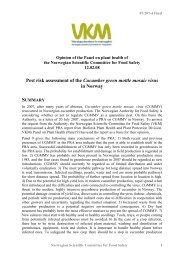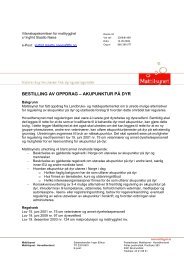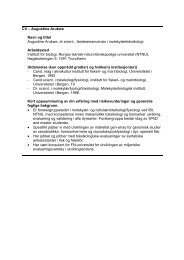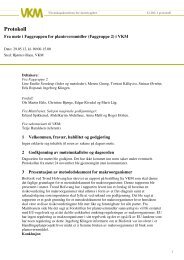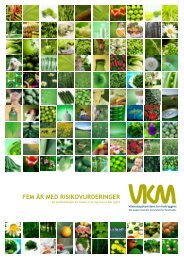Risk assessment of the pesticide Envidor with the active substance ...
Risk assessment of the pesticide Envidor with the active substance ...
Risk assessment of the pesticide Envidor with the active substance ...
Create successful ePaper yourself
Turn your PDF publications into a flip-book with our unique Google optimized e-Paper software.
<strong>Envidor</strong> - spirodicl<strong>of</strong>en10/207-endelig<strong>Risk</strong> <strong>assessment</strong> <strong>of</strong> <strong>the</strong> <strong>pesticide</strong> <strong>Envidor</strong><strong>with</strong> <strong>the</strong> <strong>active</strong> <strong>substance</strong> spirodicl<strong>of</strong>enOpinion <strong>of</strong> <strong>the</strong> Panel on plant protection productsNorwegian Scientific Committee for Food SafetyFebruary 2, 2011ISBN: 978-82-8259-015-0Norwegian Scientific Committee for Food Safety 1
<strong>Envidor</strong> - spirodicl<strong>of</strong>en10/207-endeligSUMMARY<strong>Envidor</strong> is a new product in Norway containing <strong>the</strong> <strong>active</strong> <strong>substance</strong> spirodicl<strong>of</strong>en. The product isapplied for use as an insecticide and acaricide in fruit, berries and ornamentals (field, glasshousesand tunnels). The Norwegian Scientific Committee for Food Safety (VKM) was asked by <strong>the</strong>Norwegian Food Safety Authority to perform a risk <strong>assessment</strong> on human health, environmentalfate and ecotoxicological effects <strong>of</strong> <strong>the</strong> <strong>active</strong> <strong>substance</strong> and <strong>the</strong> product. The risk <strong>assessment</strong> <strong>of</strong><strong>the</strong> product was finalized at a meeting November 25, 2010, by VKM’s Scientific Panel on plantprotection products (Panel 2). VKM Panel 2’s conclusion is as follows:Both <strong>Envidor</strong> and <strong>the</strong> <strong>active</strong> <strong>substance</strong> spirodicl<strong>of</strong>en showed low acute oral -, dermal - andinhalation toxicities in animal studies, but showed skin sensitising properties. The estimated riskfor operators is assessed as minimal provided adequate use <strong>of</strong> personal protective equipment.Spirodicl<strong>of</strong>en may have endocrine disrupting effects, but <strong>the</strong> in vivo data are not sufficient tomake a firm conclusion at this point. Adrenals and o<strong>the</strong>r organs <strong>of</strong> <strong>the</strong> endocrine system,including <strong>the</strong> reproductive system, are target organs for chronic toxicity <strong>of</strong> spriodicl<strong>of</strong>en. Malesseem to be more sensitive than females for adverse reproductive effects <strong>of</strong> spirodicl<strong>of</strong>en.Decreased testes and epididymides sizes, testes atrophy and decreased number <strong>of</strong> sperm wereseen both in <strong>the</strong> parental and subsequent generation <strong>of</strong> rats. No teratogenic effect <strong>of</strong> spirodicl<strong>of</strong>enwas seen.The disturbances in <strong>the</strong> endocrine system may account for <strong>the</strong> carcinogenic potential <strong>of</strong>spirodicl<strong>of</strong>en as evidenced by tumours in testicles, uterus and liver <strong>of</strong> animals. Spirodicl<strong>of</strong>en isnot considered genotoxic. The Panel regards spirodicl<strong>of</strong>en to be carcinogenic and toxic to <strong>the</strong>reproduction in laboratory animals.Both spirodicl<strong>of</strong>en and its metabolites are rapidly degraded in soil, but while spirodicl<strong>of</strong>en has alow mobility due to high soil sorption, its metabolites are highly mobile.Use <strong>of</strong> <strong>Envidor</strong> <strong>with</strong> <strong>the</strong> proposed application regime implies a very high risk for adverse effectson bees and non-target arthropods due to exposure to <strong>the</strong> <strong>active</strong> <strong>substance</strong> spirodicl<strong>of</strong>en. The riskfor adverse effects <strong>of</strong> spirodicl<strong>of</strong>en on o<strong>the</strong>r terrestrial organisms, and on aquatic organismsprovided that a buffer zone <strong>of</strong> 30 m to surface water is applied, is considered to be minimal.CONTRIBUTORSPersons working for VKM, ei<strong>the</strong>r as appointed members <strong>of</strong> <strong>the</strong> Committee or as ad hoc experts,do this by virtue <strong>of</strong> <strong>the</strong>ir scientific expertise, not as representatives for <strong>the</strong>ir employers. The CivilServices Act instructions on legal competence apply for all work prepared by VKM.Assessed by VKMs Panel on plant protection products (Panel 2)Members <strong>of</strong> Panel 2: Line Emilie Sverdrup (Chair), Christine Bjørge, Ole Martin Eklo, MereteGrung, Torsten Källqvist, Ingeborg Klingen, Marit Låg, Edgar Rivedal, Erik Ropstad, SteinarØvrebø.Scientific Coordinator from <strong>the</strong> Secretariat: Edel HoleneNorwegian Scientific Committee for Food Safety 2
<strong>Envidor</strong> - spirodicl<strong>of</strong>en10/207-endeligTABLE OF CONTENTSummary ......................................................................................................................................21. Background ..........................................................................................................................42. terms <strong>of</strong> reference.................................................................................................................43. <strong>Risk</strong> <strong>assessment</strong>....................................................................................................................43.1. Background documentation..........................................................................................43.2. Procedure......................................................................................................................43.3. Summary by <strong>the</strong> Norwegian Food Safety Authority (hazard identification, hazardcharacterization and <strong>assessment</strong> <strong>of</strong> exposure)..........................................................................73.3.1. Identity and physical/chemical data.........................................................................73.3.2. Mammalian toxicology.............................................................................................83.3.3. Residues in food and feed.......................................................................................113.3.4. Environmental fate and ecotoxicological effects ...................................................113.3.5. Dossier quality and completeness..........................................................................153.4. Panel 2’s <strong>assessment</strong> on health...................................................................................15Summary <strong>of</strong> human toxicity/inherent properties ....................................................................15<strong>Risk</strong> characterization <strong>of</strong> health ..............................................................................................163.5. Panel 2’s <strong>assessment</strong> <strong>of</strong> environment.........................................................................173.5.1. Summary <strong>of</strong> <strong>the</strong> environmental fate........................................................................173.5.2. Environmental risk characterization......................................................................173.6. Quality <strong>of</strong> <strong>the</strong> submitted documentation ....................................................................184. Conclusion..........................................................................................................................185. Attachment .........................................................................................................................18Norwegian Scientific Committee for Food Safety 3
<strong>Envidor</strong> - spirodicl<strong>of</strong>en10/207-endelig1. BACKGROUNDVKM performs risk <strong>assessment</strong>s in <strong>the</strong> context <strong>of</strong> <strong>pesticide</strong> registration cf. Regulation onPesticides § 4. The Norwegian Food Safety Authority, National Registration Section, isresponsible for reviewing and evaluating <strong>the</strong> documentation submitted by <strong>the</strong> <strong>pesticide</strong> notifier.The Norwegian Food Safety Authority takes <strong>the</strong> final regulatory action regarding registration orderegistration <strong>of</strong> <strong>pesticide</strong>s based on VKMs risk <strong>assessment</strong>, along <strong>with</strong> a comparative<strong>assessment</strong> <strong>of</strong> risk and benefits and <strong>the</strong> availability <strong>of</strong> alternatives (<strong>the</strong> principle <strong>of</strong> substitution).The Norwegian Food Safety Authority submitted a request on October 11, 2010 for VKM toperform a risk <strong>assessment</strong> on use <strong>of</strong> <strong>the</strong> <strong>pesticide</strong> <strong>Envidor</strong> 240 SC containing <strong>the</strong> <strong>active</strong> <strong>substance</strong>spirodicl<strong>of</strong>en. Both <strong>the</strong> environmental and <strong>the</strong> health risk <strong>assessment</strong>s <strong>of</strong> <strong>the</strong> product werefinalized by VKM’s Panel 2 at a meeting on November 25, 2010.2. TERMS OF REFERENCETerms <strong>of</strong> reference as provided by <strong>the</strong> Norwegian Food Safety Authority are as follows: ”<strong>Envidor</strong>240 SC is a new product in Norway containing <strong>the</strong> new <strong>active</strong> <strong>substance</strong> spirodicl<strong>of</strong>en. Theproduct is applied for use as an insecticide and acaricide in fruit, berries and ornamentals (field,glasshouses and tunnels). In this regard, <strong>the</strong> Norwegian Food Safety Authority asks for an<strong>assessment</strong> <strong>of</strong> <strong>the</strong> following:The human health risk for operators related to <strong>the</strong> properties <strong>of</strong> <strong>the</strong> <strong>active</strong> <strong>substance</strong> and <strong>the</strong>product. The Norwegian Food Safety Authority would also like a statement on <strong>the</strong> inherentproperties <strong>of</strong> <strong>the</strong> product, and a statement on <strong>the</strong> effects related to <strong>the</strong> limitations in <strong>the</strong>modelling. The Panel is in particular asked to look at <strong>the</strong> reproductive and carcinogeniceffects <strong>of</strong> spirodicl<strong>of</strong>en.The fate and behaviour in <strong>the</strong> environment and environmental risk <strong>with</strong> regard to <strong>the</strong>properties <strong>of</strong> <strong>the</strong> <strong>active</strong> <strong>substance</strong> spirodicl<strong>of</strong>en and <strong>the</strong> product <strong>Envidor</strong> 240 SC. The Panel isin particular asked to look at <strong>the</strong> toxicity and risk to non-target arthropods and bees. ”3. RISK ASSESSMENT3.1. Background documentationThe Panel’s risk <strong>assessment</strong> is based on <strong>the</strong> Norwegian Food Safety Authority’s evaluation(2010) <strong>of</strong> <strong>the</strong> documentation submitted by <strong>the</strong> applicant. The Norwegian Authority for FoodSafety publishes both <strong>the</strong>ir evaluation <strong>of</strong> <strong>Envidor</strong> and <strong>the</strong>ir final regulatory action on <strong>the</strong>registration <strong>of</strong> <strong>the</strong> <strong>pesticide</strong> product at <strong>the</strong>ir homepage http://www.mattilsynet.no.3.2. ProcedureThe first three steps <strong>of</strong> <strong>the</strong> risk <strong>assessment</strong> (hazard identification, hazard characterization and<strong>assessment</strong> <strong>of</strong> exposure) are performed by <strong>the</strong> Norwegian Food Safety Authority and involve an<strong>assessment</strong> <strong>of</strong> <strong>the</strong> documentation submitted by <strong>the</strong> <strong>pesticide</strong> notifier. The resulting summaryreport on hazard identification, hazard characterization and <strong>assessment</strong> <strong>of</strong> exposure, which isincluded in <strong>the</strong> present document, is <strong>the</strong>n reviewed by VKMs Panel 2. This review may result insome amendments in <strong>the</strong> original documents <strong>of</strong> both <strong>the</strong> summary report and <strong>the</strong> full reportNorwegian Scientific Committee for Food Safety 4
<strong>Envidor</strong> - spirodicl<strong>of</strong>en10/207-endeligissued by <strong>the</strong> Norwegian Food Safety Authority (2010). The fourth step (risk characterization) isbased on <strong>the</strong> three first steps and is <strong>the</strong> Panel’s conclusions or risk <strong>assessment</strong>.Health risk <strong>assessment</strong>The <strong>assessment</strong> <strong>of</strong> health risk <strong>of</strong> <strong>pesticide</strong>s is based on <strong>the</strong> adverse effects produced by <strong>the</strong> <strong>active</strong><strong>substance</strong> and product in several experimental test systems including long term animal studies.On <strong>the</strong> basis <strong>of</strong> this, limits <strong>of</strong> exposure which represent no health risk are determined. The limitstake account <strong>of</strong> <strong>the</strong> uncertainties <strong>of</strong> extrapolating data for animal to human. Then <strong>the</strong> limits arecompared to <strong>the</strong> operator exposure and human exposure to possible residues in food.The Europoem, UKPoem and <strong>the</strong> German model estimate <strong>of</strong> exposure are used to estimate <strong>the</strong>operator exposure. The models are based on a limited number <strong>of</strong> studies and are not validated.Thus, <strong>the</strong> models may not always be sufficiently representative for Norwegian conditions. Thelimitations <strong>of</strong> model estimates <strong>of</strong> exposure are taken into consideration when <strong>the</strong> calculated level<strong>of</strong> exposure is close to <strong>the</strong> threshold limit for acceptable operator exposure (Acceptable OperatorExposure Level; AOEL). The Panel uses <strong>the</strong> 75 percentile <strong>of</strong> exposure <strong>assessment</strong> for both UKpoem and German model. The Panel has to base <strong>the</strong>ir <strong>assessment</strong> on <strong>the</strong> models wheneverexposure data for <strong>the</strong> product is not presented.The Panel makes use <strong>of</strong> a higher safety factor when calculating AOEL and ADI in cases where<strong>the</strong> product contains critical <strong>active</strong> <strong>substance</strong>s <strong>with</strong> serious adverse inherent properties (toxic toreproduction or carcinogenic).In order to describe <strong>the</strong> risk <strong>of</strong> operator exposure, <strong>the</strong> Panel makes use <strong>of</strong> a risk scale. The scale isbased on <strong>the</strong> ratio between <strong>the</strong> estimated exposure based on models or measured exposure in fieldstudies and <strong>the</strong> Acceptable Operator Exposure Level (AOEL). In case <strong>the</strong> estimated exposuresignificantly exceeds AOEL, use <strong>of</strong> <strong>the</strong> products may lead to increased risk for health effects.The following risk scale is used:Very high riskHigh riskMedium riskModerate riskMinimal riskmore than 500% <strong>of</strong> <strong>the</strong> limit300 – 500% <strong>of</strong> <strong>the</strong> limit150-300% <strong>of</strong> <strong>the</strong> limit110-150% <strong>of</strong> <strong>the</strong> limit<strong>the</strong> limit is not exceededThe Panel may take into consideration critical co-formulants <strong>of</strong> <strong>the</strong> product when <strong>the</strong> degree <strong>of</strong>risk is to be determined. Consequently, if a product contains critical co-formulants it may beassessed to represent higher risk than what <strong>the</strong> inherent properties <strong>of</strong> <strong>active</strong> <strong>substance</strong>s imply.Norwegian Scientific Committee for Food Safety 5
<strong>Envidor</strong> - spirodicl<strong>of</strong>en10/207-endeligEnvironmental risk <strong>assessment</strong>The environmental risk <strong>assessment</strong> <strong>of</strong> <strong>pesticide</strong>s involves predictions <strong>of</strong> exposure concentrationsin various environmental compartments (e.g. soil and surface waters) that may occur afterapplication <strong>of</strong> <strong>the</strong> <strong>pesticide</strong>. These predicted effect concentrations (PECs) are compared toexposure levels that are known to cause toxic effects to important groups <strong>of</strong> organismsrepresenting <strong>the</strong> environmental compartments.The environmental fate and possible ecotoxicological effects <strong>of</strong> <strong>pesticide</strong>s are investigated inseveral laboratory- and field experiments. In environmental risk <strong>assessment</strong>s <strong>of</strong> <strong>pesticide</strong>s,Predicted Environmental Concentrations (PECs) are estimated by use <strong>of</strong> different scenarios fordifferent parts <strong>of</strong> <strong>the</strong> environment (terrestrial, aquatic). The first parameter estimated is usually<strong>the</strong> initial concentration (PIEC, Predicted Initial Environmental Concentration), e.g. <strong>the</strong>concentration just after application (usually spraying). PIEC in soil is calculated assuming ahomogenous distribution <strong>of</strong> areal dose in <strong>the</strong> upper 5 cm soil layer. For surface water, <strong>the</strong> PIEC isbased deposition <strong>of</strong> <strong>pesticide</strong>s from spray drift in a standard size water body. The calculations areperformed <strong>with</strong> application <strong>of</strong> buffer zones between <strong>the</strong> sprayed area and <strong>the</strong> water body.The fur<strong>the</strong>r exposure regime in different compartment is affected on <strong>the</strong> fate <strong>of</strong> <strong>the</strong> <strong>pesticide</strong>. Thefate is dependent on processes such as photodegradation, hydrolysis, biodegradation and sorptionto soil particles. These processes are studied in several standardised laboratory tests. In addition,field tests are used to study <strong>the</strong> dissipation <strong>of</strong> <strong>the</strong> <strong>pesticide</strong> in various agricultural soils.Based on <strong>the</strong> experimental fate studies, factors describing different fate processes may be derivedand used in models that describe <strong>the</strong> fate <strong>of</strong> <strong>the</strong> <strong>pesticide</strong> in <strong>the</strong> soil as well as <strong>the</strong> transport tosurface water and ground water. The concentrations <strong>of</strong> <strong>the</strong> <strong>pesticide</strong> in water are estimated by use<strong>of</strong> models <strong>with</strong> relevant scenarios based on EUs FOCUS-scenarios. The models producemaximum PNEC and average PNEC calculated for specified periods after <strong>pesticide</strong> application.In <strong>the</strong> surface water scenarios PNEC is also calculated for <strong>the</strong> sediment phase.Then <strong>the</strong> Toxicity Exposure Ratio (TER) is estimated for different groups <strong>of</strong> organisms. The TERis calculated as <strong>the</strong> ratio between <strong>the</strong> toxicity for <strong>the</strong> organism in question (expressed as LC50,EC50, NOEC etc., depending on organism and study type) and PEC or PIEC. Trigger values forTER, which express <strong>the</strong> acceptability <strong>of</strong> <strong>the</strong> risk for different organisms, have been defined by <strong>the</strong>EU. The risk is considered minimal when <strong>the</strong> TER exceeds <strong>the</strong> trigger value.In <strong>the</strong> terrestrial environment, <strong>the</strong> risk for toxic effects on bees and non-target arthropods isassessed according to o<strong>the</strong>r criteria. Hazard quotients for oral- (HQ O ) and contact toxicity (HQ C )are estimated for bees. HQ O evt. HQ C is <strong>the</strong> ratio between <strong>the</strong> standardized area dose <strong>of</strong> <strong>the</strong>product (g v.s./ha) and acute toxicity for <strong>the</strong> bee (LD50, µg <strong>active</strong> ingredient/bee). Fieldexperiments and expert evaluation is triggered whenever <strong>the</strong> hazard quotient is above 50.For <strong>the</strong> non-target arthropods, <strong>the</strong> estimated hazard quotient (HQ) is <strong>the</strong> ratio between <strong>the</strong> areadose <strong>of</strong> <strong>the</strong> product (g <strong>active</strong> ingredient/ha), which is multiplied <strong>with</strong> a factor for multipleapplications (MAF, multiple application factor) when appropriate, and <strong>the</strong> acute toxicity for <strong>the</strong>organism (LR50, g <strong>active</strong> ingredient/ha). According to EU, whenever <strong>the</strong> ratio value exceeds 2,fur<strong>the</strong>r investigations are triggered.The Panel makes use <strong>of</strong> a scale in order to describe <strong>the</strong> risk <strong>of</strong> exposure for different organismswhich live <strong>with</strong>in and outside <strong>the</strong> spraying field. The scale is based on <strong>the</strong> ratio between <strong>the</strong>Norwegian Scientific Committee for Food Safety 6
<strong>Envidor</strong> - spirodicl<strong>of</strong>en10/207-endeligestimated exposure and <strong>the</strong> limit or <strong>the</strong> ratio between <strong>the</strong> TER and <strong>the</strong> TER trigger valuedesignated each group <strong>of</strong> organism.The following risk scale is used:Very high riskHigh riskMedium riskModerate riskMinimal riskmore than 500% <strong>of</strong> <strong>the</strong> limit300 – 500% <strong>of</strong> <strong>the</strong> limit150-300% <strong>of</strong> <strong>the</strong> limit110-150% <strong>of</strong> <strong>the</strong> limit<strong>the</strong> limit is not exceededThe estimates <strong>of</strong> exposure concentrations are based on maximal concentrations, which existduring or shortly after spraying. The group <strong>of</strong> organism assessed (for example birds or leafdwelling non-target organisms) is not always present during <strong>the</strong> period <strong>of</strong> maximal concentration.In <strong>the</strong> final risk <strong>assessment</strong>, <strong>the</strong> Panel <strong>the</strong>refore takes into consideration whe<strong>the</strong>r, or to whichextent, <strong>the</strong> organism in question actually will be exposed. This may cause that <strong>the</strong> risk is assessedlower than indicated by <strong>the</strong> scale above.Additionally, uncertainties in <strong>the</strong> data base both <strong>with</strong> regard to establishments <strong>of</strong> limits andmodels <strong>of</strong> exposure concentrations are taken into consideration if relevant. This may also causethat <strong>the</strong> risk is assessed lower or higher than <strong>the</strong> risk scale. Any deviation from <strong>the</strong> risk scale isjustified in this document.3.3. Summary by <strong>the</strong> Norwegian Food Safety Authority (hazard identification,hazard characterization and <strong>assessment</strong> <strong>of</strong> exposure)<strong>Envidor</strong> 240 SC is a new product in Norway containing <strong>the</strong> new <strong>active</strong> <strong>substance</strong> spirodicl<strong>of</strong>en.The product is applied for use as an insecticide and acaricide in fruit, berries and ornamentals(field, glasshouses and tunnels). The Norwegian Institute for Agricultural and EnvironmentalResearch recommend <strong>the</strong> applied uses.The standardized area dose is 60 ml (14.4 g a.s.) per decare. There should be maximum oneapplication at uses on field, and maximum two applications at uses in glasshouses and tunnels.The application equipment differs on <strong>the</strong> crop, and can be tractor-mounted sprayers as well ashandheld sprayers.Spirodicl<strong>of</strong>en belongs to <strong>the</strong> IRAC chemical group 23: Tetronacid- and tetra-acid-derivates. Themode <strong>of</strong> action differs from o<strong>the</strong>r commercial insecticides on <strong>the</strong> Norwegian marked, but <strong>the</strong>rewill still be a potential risk <strong>of</strong> resistance.3.3.1. Identity and physical/chemical dataProduct name <strong>Envidor</strong> 240 SCActive <strong>substance</strong>FormulationSpirodicl<strong>of</strong>enSuspension concentrateNorwegian Scientific Committee for Food Safety 7
<strong>Envidor</strong> - spirodicl<strong>of</strong>en10/207-endeligConcentration <strong>of</strong><strong>active</strong> <strong>substance</strong>240 g/LCAS number 148477-71-8IUPAC-name 3-(2,4-dichlorophenyl)-2-oxo-1-oxaspiro[4.5]dec-3-en-4-yl 2,2-dimethylbutyrate (ISO) 3-(2,4-dichlorophenyl)-2-oxo-1-oxaspiro[4.5]dec-3-en-4-yl 2,2-dimethylbutanoate (ACD)Structural formulaMolecular mass411.3 g/moleSolubility in water Low 0.00019 mg/L (20°C, pH 7)Vapour pressureHenrys constantLow 3x10 -7 Pa (20°C)Medium < 2 x 10 -3 Pa m 3 /mollog Pow High 5.1 (20°C, pH 7)pKaCould not be determined, no dissociation is expected3.3.2. Mammalian toxicologySpirodicl<strong>of</strong>enToxicokineticsAbsorption: The excretion <strong>of</strong> radioactivity in urine indicates that after a single oral dose <strong>of</strong> 2mg/kg bw at least 64% (males) or 76% (females) <strong>of</strong> spirodicl<strong>of</strong>en is absorbed <strong>with</strong>in 48 h. Inano<strong>the</strong>r study at least 60% (males) or 75% (females) <strong>of</strong> <strong>the</strong> administered spirodicl<strong>of</strong>en wasabsorbed <strong>with</strong>in 24 h. If <strong>the</strong> amount in bile is included <strong>the</strong> absorption in males is increased to70%. The faecal excretion <strong>of</strong> radioactivity in bile-duct cannulated rats treated <strong>with</strong> a single oraldose <strong>of</strong> 1 mg/kg bw <strong>of</strong> spirodicl<strong>of</strong>en suggests incomplete absorption. The level <strong>of</strong> absorptionseems to decrease <strong>with</strong> increasing oral doses and after pretreatment <strong>with</strong> a high dose.Distribution: Levels <strong>of</strong> radioactivity in organs and tissues were low, and <strong>the</strong> relative distributionwas similar for all experimental groups. Depending on <strong>the</strong> time <strong>of</strong> sampling peak tissue levelsNorwegian Scientific Committee for Food Safety 8
<strong>Envidor</strong> - spirodicl<strong>of</strong>en10/207-endeligwere observed at 3-8 h after administration. Highest levels <strong>of</strong> radioactivity were observed inliver, kidney, plasma, gastrointestinal tract and skin. In females, organ and tissue levels were 5-15times lower than in males. In male rats treated <strong>with</strong> spirodicl<strong>of</strong>en for 15 days, tissue levels wereabout 4 times lower than in males treated <strong>with</strong> a single dose <strong>of</strong> spirodicl<strong>of</strong>en. Only traces <strong>of</strong>radioactivity was found in <strong>the</strong> testis (0.003 pg/g) and nothing were detected in o<strong>the</strong>r organsinvolved in hormonal regulation (e.g. in <strong>the</strong> adrenal and thyroid gland).Metabolism: A marked sex difference in metabolite pr<strong>of</strong>ile was observed. The main metabolite infemale rats was M01 (54.8%), while this metabolite only represented 2.3 - 3.8% in males. In malerats <strong>the</strong> major metabolites were <strong>the</strong> M02 and M03 isomers, representing 55.1 - 57.4% <strong>of</strong> totalradioactivity. In females <strong>the</strong>se metabolites only represented 17.3%, indicating a higher capacityin fur<strong>the</strong>r metabolization <strong>of</strong> <strong>the</strong> enol metabolite in male rats. In plasma, liver and kidney samples<strong>of</strong> males as well as females enol was <strong>the</strong> main metabolite. The parent compound was not detectedin urine or bile. In faeces it accounted for 3.4 % in male and 0.4% in female rats pre-treated <strong>with</strong>50 ppm and 5.7% in male and 16% in female rats pre-treated <strong>with</strong> 2500 ppm.Excretion: Following administration <strong>of</strong> 2 mg 14 C-spirodicl<strong>of</strong>en/kg bw to male rats at least 88% <strong>of</strong><strong>the</strong> administered dose (99% <strong>of</strong> recovered radioactivity) was excreted <strong>with</strong>in 48 h. Afteradministration <strong>of</strong> 100 mg spirodicl<strong>of</strong>en /kg bw, 96% <strong>of</strong> <strong>the</strong> administered dose (100% <strong>of</strong>recovered radioactivity) was excreted <strong>with</strong>in 168h. Elimination half-life was 3.5-5.3 hours.Acute toxicitySpirodicl<strong>of</strong>en has low acute toxicity to rats following oral, dermal or inhalative administration.Irritation and sensitisationSpirodicl<strong>of</strong>en is considered not irritating to skin and eye, but it exhibits a skin sensitisingpotential and meets <strong>the</strong> criteria for classification as Xi; R43 May cause sensitisation by skincontact.GenotoxicitySpirodicl<strong>of</strong>en did not induce mutations in bacteria. The point mutations test in mammalian cellsin vitro gave equivocal results. Statistically significant increases in mutant frequency wereobserved in one culture <strong>with</strong> and one culture <strong>with</strong>out metabolic activation. The results were notreproduced in parallel treated cultures or in a second trial, and it was no dose-response. Toexclude <strong>the</strong> possibility <strong>of</strong> point mutations in vivo however, a second in vivo test would have beenpreferable. The results <strong>of</strong> <strong>the</strong> chromosomal aberration study in mammalian cells in vitro werealso equivocal. A statistically significant increase in aberrations were observed (+/-S9), but <strong>the</strong>values are <strong>with</strong>in <strong>the</strong> range <strong>of</strong> historical controls. Spirodicl<strong>of</strong>en was found to be negative in an invivo micronucleus test. Based on <strong>the</strong>se results, spirodicl<strong>of</strong>en is considered to be non-genotoxic.Sub-chronic and chronic toxicityThe adrenals, where effects on weight and/or histopathology are observed already at low doses,seem to be target organs in both rats, mice and dogs. Effects on <strong>the</strong> adrenals were observed bothin sub-chronic and chronic studies. In addition to <strong>the</strong> adrenals also o<strong>the</strong>r organs <strong>of</strong> <strong>the</strong> endocrinesystem, included reproductive organs, were affected in all test species. Effects on haematologicaland clinical biochemical parameters included reduction <strong>of</strong> cholesterol and triglyceride levels werealso observed.CarcinogenicitySpirodicl<strong>of</strong>en is considered carcinogenic for inducing Leydig cell tumours and uterusadenocarcinomas in <strong>the</strong> rat (NOAEL 14.72 mg/kg bw/day), and for inducing liver tumours in <strong>the</strong>Norwegian Scientific Committee for Food Safety 9
<strong>Envidor</strong> - spirodicl<strong>of</strong>en10/207-endeligmouse (NOAEL 4.1 mg/kg bw/day). Classification as Xn; R40 Limited evidence <strong>of</strong>carcinogenic effect is proposed.Reproductive toxicity and teratologyCritical effects in F0 animals in <strong>the</strong> 2-generation study in rats were decreased body and liverweight and decreased blood cholesterol in males and decreased triglyceride concentration in bothmales and females. In F1 males effects on <strong>the</strong> testes and epididymides were observed at all doselevels. In <strong>the</strong> highest dose group, effects on spermatogenesis in F1 males were observed, and fourmales failed to reproduce. Based on <strong>the</strong> reproductive effects, spirodicl<strong>of</strong>en fulfil <strong>the</strong> criteria forclassification as Xn; R60 May impair fertility / R62 Possible risk <strong>of</strong> impaired fertility.In <strong>the</strong> teratology study in rats no adverse effects were observed at any dose level. Criticalmaternal effect in <strong>the</strong> rabbit study was a significant decrease in body weight in <strong>the</strong> two highestdose groups. The critical developmental effect was an increased incidence <strong>of</strong> liver lobulation infoetuses <strong>of</strong> <strong>the</strong> highest dose group, <strong>with</strong> a NOAEL (developmental) <strong>of</strong> 300 mg/kg bw/day.Spirodicl<strong>of</strong>en is not considered as teratogenic.NeurotoxicitySpirodicl<strong>of</strong>en is not considered neurotoxic. No effects were observed in <strong>the</strong> acute ordevelopmental neurotoxicity studies. In <strong>the</strong> sub-chronic study decreased foot splay and gripstrength and reduced motor and locomotor activity were observed, but only at high doses and in<strong>the</strong> presence <strong>of</strong> general toxicity. The functional observational battery test conducted in <strong>the</strong>combined study on chronic toxicity and carcinogenicity in Wistar rats did not reveal any relevantsigns or symptoms indicating evidence for neurotoxic potential <strong>of</strong> spirodicl<strong>of</strong>en.Special studiesBased on <strong>the</strong> mechanistic studies, <strong>the</strong> notifier concluded that M01 interferes <strong>with</strong> steroidhormone syn<strong>the</strong>sis at <strong>the</strong> level <strong>of</strong> general biochemical pathways /pyruvate/citrate shuttle (Krebscycle) but has no direct effects on steroid syn<strong>the</strong>sis. In addition, <strong>the</strong> notifier concluded thatdecreased levels <strong>of</strong> reducing equivalents (e.g. NADH and NADPH) unspecifically lower <strong>the</strong>syn<strong>the</strong>sis <strong>of</strong> cholesterol, triglycerides and steroid hormones. Inhibition <strong>of</strong> steroid hormonebiosyn<strong>the</strong>sis increases <strong>the</strong> release <strong>of</strong> adrenocorticotrophins and gonadotrophins from <strong>the</strong> pituitarygland. The increase in gonadotrophins <strong>the</strong>n results in chronic stimulation <strong>of</strong> testicular Leydigcells and uterine cells, resulting in hypertrophy, hyperplasia and tumour formation. Theseconsiderations seem plausible, and it can be concluded that <strong>the</strong> carcinogenic potential <strong>of</strong>spirodicl<strong>of</strong>en should be regarded as a non-genotoxic carcinogenic mechanism. Because <strong>of</strong> <strong>the</strong>interference <strong>with</strong> steroid hormone syn<strong>the</strong>sis, spirodicl<strong>of</strong>en should be regarded as an endocrinedisruptor.Medical dataNo reports about human findings are available and a specific antidote is not known. In case <strong>of</strong>oral uptake, first aid measures should consist <strong>of</strong> removal <strong>of</strong> ingested compound by gastric lavageor induction <strong>of</strong> vomiting and symptomatic treatment. Contaminated skin should be washedimmediately <strong>with</strong> plenty <strong>of</strong> water.<strong>Envidor</strong> 240 SCCo-formulantsSpirodicl<strong>of</strong>en does not contain co-formulants occurring above <strong>the</strong> limit that trigger labellingaccording to <strong>the</strong> dangerous <strong>substance</strong> list.Norwegian Scientific Committee for Food Safety 10
<strong>Envidor</strong> - spirodicl<strong>of</strong>en10/207-endeligAcute toxicity<strong>Envidor</strong> 240 SC has low acute toxicity to rats following oral, dermal or inhalative administration.Irritation and sensitisationSpirodicl<strong>of</strong>en is considered not irritating to skin and eye, but it exhibits a skin sensitisationpotential (classified as Xi; R43 May cause sensitisation by skin contact).Dermal absorptionBased on <strong>the</strong> in vitro study <strong>with</strong> human skin <strong>the</strong> dermal absorption is 0.6% for <strong>the</strong> concentrateand 7% for <strong>the</strong> dilution. The monkey studies were regarded as being <strong>of</strong> limited value because <strong>of</strong>dose selection, low recovery in <strong>the</strong> main study and limited number <strong>of</strong> experimental animals.Operator, worker and bystander exposureUK Poem estimate <strong>of</strong> exposure suggests that <strong>the</strong> level <strong>of</strong> exposure will be acceptable foroperators <strong>with</strong>out PPE for application using tractor-mounted sprayers. Because <strong>of</strong> <strong>the</strong> sensitisingproperties <strong>of</strong> <strong>Envidor</strong> 240 SC (Xi; R43) however, gloves should always be used when handling<strong>the</strong> product. For application <strong>with</strong> handheld sprayers <strong>the</strong> UK POEM estimate <strong>of</strong> exposure requiresgloves to be worn during mixing and loading and during application in fruits and berries. Inornamental plants, AOEL is exceeded even when full protective equipment (gloves andimpermeable coverall) is used.Worker exposure following re-entry estimated using an exposure model proposed by Hoernickeet al. (1998) and Krebs et al. (2000) show that <strong>the</strong> exposure is acceptable <strong>with</strong>out use <strong>of</strong> PPE.Although <strong>the</strong> estimated worker exposure is below <strong>the</strong> AOEL however, use <strong>of</strong> gloves should beworn to minimize exposure and because <strong>of</strong> <strong>the</strong> sensitising properties <strong>of</strong> <strong>Envidor</strong> 240 SC.Estimation <strong>of</strong> bystander exposure using EUROPOEM II shows that bystanders are not at risk.3.3.3. Residues in food and feedThis is not included in this report.3.3.4. Environmental fate and ecotoxicological effectsEnvironmental fate and behaviourDegradation in soilThe degradation rate <strong>of</strong> spirodicl<strong>of</strong>en is high to moderate, DT50: 1-13 days, geometric meanDT50: 5.4 days. DT90: 3.8-44 days, geometric mean 18.4 days. The per cent mineralization <strong>of</strong>spirodicl<strong>of</strong>en is high 23-93 % <strong>of</strong> AR and <strong>the</strong> formation <strong>of</strong> bound residues is between 7 and 14 %<strong>of</strong> AR. Four main metabolites were observed and <strong>the</strong> following DT50-values were calculated.BAJ 277740-enol: 1.9-9.8 days. BAJ 2740-ketohydroxy: 0.6-27 days. BAJ 2740-dihydroxy: 3.8-30 days. 2,4-dichlorobenzoic acid: 3.5-11 days. An anaerobic soil degradation study has not beenperformed. DT50lab (10°C, aerobic) was calculated from DT50lab (20°C, using a Q10 factor <strong>of</strong>2.58). The degradation rate is high to moderate, DT50: 2.8- 34 days. DT90: 10-114 days.Photolysis is not an important route <strong>of</strong> degradation for spirodicl<strong>of</strong>en. No field studies weresubmitted on <strong>the</strong> basis that <strong>the</strong> laboratory degradation <strong>of</strong> spirodicl<strong>of</strong>en and major metabolites is
<strong>Envidor</strong> - spirodicl<strong>of</strong>en10/207-endeligSorption/mobilityThe sorption <strong>of</strong> spirodicl<strong>of</strong>en to soil can be classified as very high <strong>with</strong> a Koc-value <strong>of</strong> 31037.The sorption <strong>of</strong> <strong>the</strong> metabolites BAJ 2740-enol, BAJ 2740-dihydroxy and 2,4-dichlorobenzoicacid can be classified as low, while <strong>the</strong> sorption <strong>of</strong> BAJ 2740-ketohydroxy can be classified asmoderate. An aged column study is performed. Based on <strong>the</strong> amount <strong>of</strong> radioactivity in <strong>the</strong>leachate, <strong>the</strong> mobility <strong>of</strong> spirodicl<strong>of</strong>en is low and <strong>the</strong> mobility <strong>of</strong> <strong>the</strong> main metabolites is high.Degradation in waterThe hydrolysis <strong>of</strong> spirodicl<strong>of</strong>en is moderate at pH 7. In sterile aqueous buffer solutions,spirodicl<strong>of</strong>en hydrolysed <strong>with</strong> first order DT50 <strong>of</strong> 120 (pH 4), 52 days (pH 7) and 2.5 days (pH 9)at 20 °C. The hydrolytic stability <strong>of</strong> spirodicl<strong>of</strong>en decreases as temperature and pH increase.Photolysis is not an important degradation pathway for spirodicl<strong>of</strong>en. No study is submitted onready biodegradability. The low formation rate <strong>of</strong> CO 2 in aerobic water-sediment studies (2.1-2.6%) suggests that <strong>the</strong> <strong>substance</strong> is not readily biodegradable.The degradation <strong>of</strong> spirodicl<strong>of</strong>en for <strong>the</strong> whole water sediment system can be classified as high<strong>with</strong> DT50: 2.3-4.2 days. DT90: 7.5-14 days. Mineralization was at low level and only smallamounts <strong>of</strong> bound residues was formed. Spirodicl<strong>of</strong>en quickly partitioned into sediment. Themajor metabolite was BAJ2740-enol, <strong>with</strong> maximum levels <strong>of</strong> 84% <strong>of</strong> AR and 30% <strong>of</strong> AR inwater and sediment, respectively. DT50 values for BAJ 2740-enol in <strong>the</strong> pond system were 393days and in <strong>the</strong> pit system, no degradation <strong>of</strong> BAJ 2740-enol was apparent until study end.Fate in airMeasured volatilisation <strong>of</strong> spirodicl<strong>of</strong>en from soil and leaf surfaces under field conditions wasnegligible DT50air: 2.7 hours. Vaporization: Henry’s Law constant: 2 x 10 -3 Pa/mol m 3 . The datasuggested that <strong>the</strong> concentrations <strong>of</strong> spirodicl<strong>of</strong>en are likely to be negligible.ExposureAccording to a simple model recommended by <strong>the</strong> EU working group FOCUS <strong>the</strong> expectedPIEC, predicted initial environmental concentration, in soil is 0.096 mg a.s./kg after <strong>the</strong>application <strong>of</strong> 144 g a.s./ha <strong>with</strong> 50 % interception.GroundwaterThe leaching behaviour <strong>of</strong> Spirodicl<strong>of</strong>en was evaluated using all <strong>the</strong> nine FOCUS groundwaterscenarios and <strong>the</strong> two recommended models, i.e. FOCUS-PELMO (version 3.3.2) andFOCUSPEARL (version 2.2.2). The use considered was <strong>Envidor</strong> in apple according to <strong>the</strong>representative GAP, i.e. a single application <strong>of</strong> 144 g a.s./ha. The interception was 65%, thus <strong>the</strong>application rate used for all scenarios was 144 g a.s./ha x 35%, or 50 g a.s./ha. These modelling<strong>assessment</strong>s indicate that a contamination <strong>of</strong> groundwater <strong>of</strong> spirodicl<strong>of</strong>en and its metabolites isunlikely to occur.Surface waterPECsw <strong>of</strong> spirodicl<strong>of</strong>en was recalculated by <strong>the</strong> RMS using <strong>the</strong> following assumptions.(i) Single application <strong>of</strong> 144 g a.s./ha (orchard crops).(ii) Entry into surface water via drift, based on 90th percentile drift values taken from <strong>the</strong>Guidance Document on Aquatic Ecotoxicology (8075/VI/97 rev 8); drift values for earlyand late stage for orchard crops..Norwegian Scientific Committee for Food Safety 12
<strong>Envidor</strong> - spirodicl<strong>of</strong>en10/207-endelig(iii(iv)Equal distribution in a static water body <strong>of</strong> 30 cm depth.DT50 dissipation <strong>of</strong> 1.1 days from water (maximum 1 st order DT50 from water phase).Under <strong>the</strong> above assumptions, early application <strong>of</strong> <strong>Envidor</strong> according to GAP will lead to PEC SWvalues for Spirodicl<strong>of</strong>en for instance <strong>of</strong> 14 µg/L for 3 m buffer zones. The initial PEC SW <strong>of</strong> <strong>the</strong>metabolite BAJ 2740-enol was derived from that <strong>of</strong> <strong>the</strong> <strong>active</strong> <strong>substance</strong>, <strong>with</strong> corrections for <strong>the</strong>difference in molecular mass (correction factor 313.2/411.3) and <strong>the</strong> maximum percentage atwhich <strong>the</strong> metabolite was formed from <strong>the</strong> parent <strong>substance</strong> in <strong>the</strong> water phase <strong>of</strong> water/sedimentsystems (84% <strong>of</strong> AR).Terrestrial organismsWhere <strong>the</strong>re are indications that <strong>the</strong> plant protection product is more toxic than what can beexplained by <strong>the</strong> content <strong>of</strong> <strong>active</strong> <strong>substance</strong> (or studies are only conducted <strong>with</strong> <strong>the</strong> product), oridentified metabolites are more toxic than <strong>the</strong> <strong>active</strong> <strong>substance</strong>, <strong>the</strong>se calculations are included in<strong>the</strong> summary below. If this is not <strong>the</strong> case, <strong>the</strong>se values and calculations are omitted.MammalsLow acute toxicity to mammals (LD50: >2500 mg/kg bw/d). TER for <strong>the</strong> indicator species smallherbivorous mammal in orchards is estimated as >147. This value does not exceed <strong>the</strong> trigger(257. This value does not exceed <strong>the</strong> EU trigger(1061 mg/kg bw/d). TER for <strong>the</strong> indicator species inorchards is estimated as >244. This value does not exceed <strong>the</strong> trigger. Chronic toxicity (NOEC:51 mg/kg bw/d). A reproductive toxicity study showed no effects on reproductive parameters upto and including <strong>the</strong> highest does level. TER is estimated to be 12. This value does not exceed <strong>the</strong>EU trigger (200 µg/bee) and oral toxicity to bees (LD50: >196 µg/bee). Hazardquotients for contact (Qhc) and oral exposure (Qho) are estimated to be
<strong>Envidor</strong> - spirodicl<strong>of</strong>en10/207-endeligEarthwormsLow acute toxicity to earthworms (LC50: >1000 mg/kg d.w. soil). TER is estimated to be 10417.This value does not exceed <strong>the</strong> trigger (100 mg a.s./L). Chronically toxic to Daphniamagna (21d NOEC: 0.0111 mg a.s./L). Low toxicity to Daphnia magna <strong>of</strong> <strong>the</strong> metabolite BAJ2740-enol. All TER calculations for spirodicl<strong>of</strong>en pass <strong>the</strong> EU triggers (Acute: 100, Chronic: 10)<strong>with</strong> a buffer zone <strong>of</strong> 30 meters.Sediment dwelling organismsToxic to Chironomus riparius larvae (28d NOEC: 0.032 mg a.s./L (spiked water)). Low toxicity<strong>of</strong> <strong>the</strong> metabolite BAJ 2740-enol. TER calculations for spirodicl<strong>of</strong>en pass <strong>the</strong> EU trigger (10)<strong>with</strong> a buffer zone <strong>of</strong> 20 meters.AlgaeToxic to algae (96h EC50: >4.6 mg a.s./L). TER calculations for spirodicl<strong>of</strong>en pass <strong>the</strong> EUtrigger (10) <strong>with</strong> a buffer zone <strong>of</strong> 3 meters.Microcosm/Mesocosm studiesNo information.BioconcentrationHigh potential for bioaccumulation. The BCF <strong>of</strong> Spirodicl<strong>of</strong>en, based on total radioactivity, wasdetermined to be 491 L/kg for whole fish. This exceeds <strong>the</strong> trigger value <strong>of</strong> 100. However, <strong>the</strong>proposed use in orchards involves a single seasonal application, <strong>the</strong> exposure time will berelatively short, and it rapidly depurates from fish (90% clearance time <strong>of</strong> total residues is 2Norwegian Scientific Committee for Food Safety 14
<strong>Envidor</strong> - spirodicl<strong>of</strong>en10/207-endeligdays). The BCF for <strong>the</strong> metabolite BAJ 2740-enol for fish is estimated to be 71 L/kg wet weightwhich is below <strong>the</strong> trigger <strong>of</strong> 100.3.3.5. Dossier quality and completenessThe dossier is complete and is adequate as a basis for an evaluation <strong>of</strong> <strong>the</strong> <strong>active</strong> <strong>substance</strong>,metabolites and product.3.4. Panel 2’s <strong>assessment</strong> on healthSummary <strong>of</strong> human toxicity/inherent propertiesPanel 2 has reviewed <strong>the</strong> actual documentation and points out <strong>the</strong> following inherent properties <strong>of</strong><strong>the</strong> product, <strong>the</strong> <strong>active</strong> <strong>substance</strong> and possible metabolites:Spirodicl<strong>of</strong>en showed low acute toxicity in rats both following oral- and dermal administrationand inhalation, but showed skin sensitisation properties. The Panel concludes that spirodicl<strong>of</strong>en isnot considered genotoxic, even though equivocal results concerning chromosomal aberrationsappeared in in vitro test systems.In <strong>the</strong> sub-chronic and chronic toxicity testing, <strong>the</strong> adrenals appeared to be a target organ in alltested species where effects on organ weight and/or histopathology were observed already at lowdoses. In addition to <strong>the</strong> adrenals, o<strong>the</strong>r organs <strong>of</strong> <strong>the</strong> endocrine system including reproductiveorgans were affected in all species tested. Reductions <strong>of</strong> cholesterol- and triglyceride levels wereobserved at low doses. Increased incidences <strong>of</strong> Leydig cell adenomas and uterineadenocarcinomas were observed in exposed rats, and liver adenomas/adenocarcinomas in mice.Generally, males seem more sensitive for adverse reproductive effects <strong>of</strong> spirodicl<strong>of</strong>en thanfemales. This may mirror <strong>the</strong> tissue levels <strong>of</strong> spirodicl<strong>of</strong>en which was 5-15 times higher in malesthan in females.In <strong>the</strong> 2-generation study in rats, dose related trends towards decreased testes and epididymidessizes in F1 males were seen when evaluated by gross pathological examinations. Decreasedepididymides- and seminal vesicle weights and increased weight <strong>of</strong> prostate were seen in F0males exposed to <strong>the</strong> lowest doses. Decreased liver weight was seen in all treatment groups.In F1 males, dose related trends towards increased incidence <strong>of</strong> atrophy and a decreased number<strong>of</strong> spermatides per mg tissues in testes and epididymides were observed. The mid and highestdose in F1 males and at <strong>the</strong> highest dose in females, decreased levels <strong>of</strong> cholesterol andtriglyceride concentrations were seen.No teratogenic effect was found in rats or rabbits. Spirodicl<strong>of</strong>en is not considered neurotoxic inadult or developing rats.Based on mechanistic studies, it was indicated that <strong>the</strong> steroid hormone syn<strong>the</strong>sis was decreasedcausing increased hormone secretion at <strong>the</strong> higher levels <strong>of</strong> hormone axis (hypothalamuspituitary-gonadaland -adrenal axes). A possible mechanism <strong>of</strong> action could be that increasinglevels <strong>of</strong> pituitary hormones could be associated <strong>with</strong> hyperplasia and tumour formation intesticular tissue, and hypertrophy and vacuolization in <strong>the</strong> adrenals. The Panel concludes thatspirodicl<strong>of</strong>en may have endocrine disrupting effects because it interferes <strong>with</strong> steroid hormoneNorwegian Scientific Committee for Food Safety 15
<strong>Envidor</strong> - spirodicl<strong>of</strong>en10/207-endeligsyn<strong>the</strong>sis in vitro. However, <strong>the</strong> in vivo data are not sufficient to make a firm conclusion on thispoint.The product <strong>Envidor</strong> 240 SC<strong>Envidor</strong> 240 SC showed low acute toxicity to rats both following oral- and dermal administrationand inhalation. The product showed no irritation to skin or eye, but showed skin sensitisingproperties as evaluated in <strong>the</strong> guinea pig (in 20/20 animals). <strong>Envidor</strong> 240 SC is absorbed throughhuman skin at an estimated rate <strong>of</strong> 0.6% and 7% for <strong>the</strong> concentrate and <strong>the</strong> dilution, respectively.National norms are set as follows:ADI – Acceptable Daily IntakeAn ADI <strong>of</strong> 0.014 mg/kg bw/day is determined based on applying a 100-fold safety factor to <strong>the</strong>NOAEL <strong>of</strong> 1.38 mg/kg bw/day from <strong>the</strong> 1-year study in dogs.AOEL - Acceptable Operator Exposure LevelAn AOEL <strong>of</strong> 0.009 mg/kg bw/day is determined based on applying a 100-fold safety factor to <strong>the</strong>NOAEL <strong>of</strong> 1.38 mg/kg bw/day from <strong>the</strong> 1-year study in dogs and additionally applying acorrection factor <strong>of</strong> 0.64 to account for oral absorption.The Panel concludes that it is not necessary to establish an ARfD for spirodicl<strong>of</strong>en due to its lowacute toxicity.Metabolites and impurities – possible exposure to humans via <strong>the</strong> environmentThe metabolites (M01 and BAJ2740-ketohydroxy/MA-3OH-cyclohexylester) detected in <strong>the</strong>soil/groundwater or in plants were tested for acute toxicity orally and for bacterial mutagenicity.The studies show that <strong>the</strong> metabolites have low acute toxicity, except M01 that is moderatelytoxic. The metabolites tested negative in bacterial mutagenicity studies.<strong>Risk</strong> characterization <strong>of</strong> healthHealth risk due to human exposureThe Panel has based <strong>the</strong>ir risk characterization for operators <strong>of</strong> <strong>Envidor</strong> 240 SC on <strong>the</strong> exposureanddose-response <strong>assessment</strong>s presented in section 3.3.1 by applying <strong>the</strong> risk scale described insection 3.2.Operator, worker and bystander exposureOperator exposureThe estimated risk for operators provided adequate use <strong>of</strong> personal protective equipment (PPE) isassessed as minimal as <strong>the</strong> estimated exposure (UK POEM) for different uses gave a maximumvalue <strong>of</strong> 102% <strong>of</strong> AOEL. However, because <strong>of</strong> <strong>the</strong> skin sensitising properties <strong>of</strong> <strong>Envidor</strong> 240 SC,gloves should always be used when handling <strong>the</strong> product.Worker exposureThe risk for workers from exposure to spirodicl<strong>of</strong>en is assessed as minimal (74% <strong>of</strong> AOEL).However, because <strong>of</strong> <strong>the</strong> skin sensitising properties <strong>of</strong> <strong>Envidor</strong> 240 gloves should always be usedwhen handling treated crops.Bystander exposureNorwegian Scientific Committee for Food Safety 16
<strong>Envidor</strong> - spirodicl<strong>of</strong>en10/207-endeligThe risk for bystander from exposure to spirodicl<strong>of</strong>en is assessed as minimal (8-14% <strong>of</strong> AOEL).Health risk due to residues in products for consumptionNot included in <strong>the</strong> terms <strong>of</strong> reference.3.5. Panel 2’s <strong>assessment</strong> <strong>of</strong> environment3.5.1. Summary <strong>of</strong> <strong>the</strong> environmental fatePanel 2 has reviewed <strong>the</strong> actual documentation and points out <strong>the</strong> following inherent properties <strong>of</strong><strong>the</strong> product, <strong>the</strong> <strong>active</strong> <strong>substance</strong> and possible metabolites:Spirodicl<strong>of</strong>en is rapidly degraded in soils and has a low mobility due to high soil sorption. Inareas <strong>with</strong> high risk <strong>of</strong> erosion and run-<strong>of</strong>f, transport <strong>of</strong> spirodicl<strong>of</strong>en sorbed to soil particles islikely to occur. Several metabolites are formed which are highly mobile but generally rapidlydegraded in soils.3.5.2. Environmental risk characterizationThe risk characterization <strong>of</strong> <strong>the</strong> product’s ecotoxicological effects on <strong>the</strong> terrestrial and aquaticenvironments made by Panel 2 is based on <strong>the</strong> exposure- and dose/response <strong>assessment</strong>spresented in section 3.3.3 by applying <strong>the</strong> risk scale described in section 3.2.Ecotoxicological effects on terrestrial organismsThe Panel concludes that <strong>the</strong>re is minimal risk for toxic effects <strong>of</strong> spirodicl<strong>of</strong>en on mammals,birds, earthworms, and soil microorganisms <strong>with</strong> <strong>the</strong> proposed application regime.For bees, standard laboratory studies show low oral and contact toxicity to adult bees. The Panelconsiders <strong>the</strong>se studies not to be relevant based on <strong>the</strong> mode <strong>of</strong> action <strong>of</strong> spirodicl<strong>of</strong>en.Spirodicl<strong>of</strong>en is an Insect Growth Regulator (IGR) which means that it interrupts <strong>the</strong> bees’ lifecycle by inhibiting <strong>the</strong> development <strong>of</strong> immature stages (e.g. larvae and pupae). Several semifield-and field experiments have documented adverse effects <strong>of</strong> spirodicl<strong>of</strong>en on bee brooddevelopment and pupal abundance at <strong>the</strong> proposed application rate. The Panel concludes that thisindicates very high risk for toxic effects <strong>of</strong> spirodicl<strong>of</strong>en to bees when <strong>the</strong> <strong>substance</strong> is appliedduring flowering.Both laboratory- and field studies <strong>with</strong> non-target arthropods (predatory mites) show adverseeffects above <strong>the</strong> trigger value at <strong>the</strong> suggested application rate for spirodicl<strong>of</strong>en. Even thoughone field experiment indicated recovery <strong>with</strong>in one year, <strong>the</strong> Panel considers <strong>the</strong> risk to nontargetarthropods to be very high.Ecotoxicological effects on aquatic organismsExposure concentrations have been estimated based on spray drift during application in orchardswhich is considered by <strong>the</strong> Panel to be <strong>the</strong> worst case scenario in terms <strong>of</strong> exposure. The Panelconcludes that <strong>the</strong>re is a minimal risk <strong>of</strong> toxic effects on aquatic organisms due to exposure tospirodicl<strong>of</strong>en <strong>with</strong> <strong>the</strong> proposed application regime, provided that a buffer zone <strong>of</strong> 30 m tosurface water is applied.Norwegian Scientific Committee for Food Safety 17
<strong>Envidor</strong> - spirodicl<strong>of</strong>en10/207-endelig3.6. Quality <strong>of</strong> <strong>the</strong> submitted documentationPanel 2 is <strong>of</strong> <strong>the</strong> opinion that <strong>the</strong> documentation submitted to VKM is adequate as a basis for anevaluation <strong>of</strong> <strong>the</strong> <strong>active</strong> <strong>substance</strong>, <strong>the</strong> metabolites, and for <strong>the</strong> technical material4. CONCLUSIONVKMs Panel 2 concludes as following:Both <strong>Envidor</strong> and <strong>the</strong> <strong>active</strong> <strong>substance</strong> spirodicl<strong>of</strong>en showed low acute oral -, dermal - andinhalation toxicities in animal studies, but showed skin sensitising properties. The estimated riskfor operators is assessed as minimal provided adequate use <strong>of</strong> personal protective equipment.Spirodicl<strong>of</strong>en may have endocrine disrupting effects, but <strong>the</strong> in vivo data are not sufficient tomake a firm conclusion at this point. Adrenals and o<strong>the</strong>r organs <strong>of</strong> <strong>the</strong> endocrine system,including <strong>the</strong> reproductive system, are target organs for chronic toxicity <strong>of</strong> spriodicl<strong>of</strong>en. Malesseem to be more sensitive than females for adverse reproductive effects <strong>of</strong> spirodicl<strong>of</strong>en.Decreased testes and epididymides sizes, testes atrophy and decreased number <strong>of</strong> sperm wereseen both in <strong>the</strong> parental and subsequent generation <strong>of</strong> rats. No teratogenic effect <strong>of</strong> spirodicl<strong>of</strong>enwas seen.The disturbances in <strong>the</strong> endocrine system may account for <strong>the</strong> carcinogenic potential <strong>of</strong>spirodicl<strong>of</strong>en as evidenced by tumours in testicles, uterus and liver <strong>of</strong> animals. Spirodicl<strong>of</strong>en isnot considered genotoxic. The Panel regards spirodicl<strong>of</strong>en to be carcinogenic and toxic to <strong>the</strong>reproduction in laboratory animals.Both spirodicl<strong>of</strong>en and its metabolites are rapidly degraded in soil, but while spirodicl<strong>of</strong>en has alow mobility due to high soil sorption, its metabolites are highly mobile.Use <strong>of</strong> <strong>Envidor</strong> <strong>with</strong> <strong>the</strong> proposed application regime implies a very high risk for adverse effectson bees and non-target arthropods due to exposure to <strong>the</strong> <strong>active</strong> <strong>substance</strong> spirodicl<strong>of</strong>en. The riskfor adverse effects <strong>of</strong> spirodicl<strong>of</strong>en on o<strong>the</strong>r terrestrial organisms, and on aquatic organismsprovided that a buffer zone <strong>of</strong> 30 m to surface water is applied, is considered to be minimal.5. ATTACHMENTThe Norwegian Food Safety Authority’s evaluation <strong>of</strong> <strong>the</strong> documentation submitted by <strong>the</strong>applicant, following application for registration <strong>of</strong> <strong>the</strong> insecticide/acaricide <strong>Envidor</strong> 240 SC(spirodicl<strong>of</strong>en), 2010.Norwegian Scientific Committee for Food Safety 18



